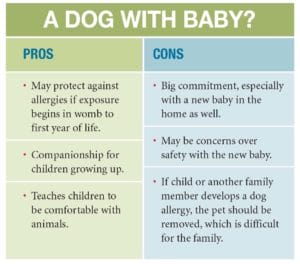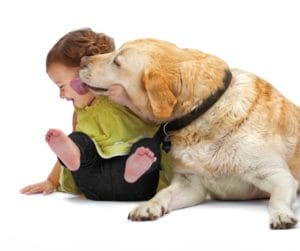 Photo: Getty
Photo: Getty Want to protect your child against allergies? Increasingly science is saying: get a dog, and get it early.
Pamela Phillips grew up with allergies but that didn’t stop her family from owning low-shedding dogs when she was younger. “I never really had allergies to our dogs,” she recalls. As an adult she and her husband got a cat and, a couple of years before their son Liam was born, they added a dog to the family. Things were going pretty well with Phillips’ allergies, until she got pregnant. Her eczema flared and, at the same time, she found herself too tired to take care of the dog properly. Her mother-in-law took the German shepherd-cross as a way to help out temporarily.
Then shortly after Liam was born, Phillips started having asthma attacks. The new mother would wake up at night struggling to breathe. (She saw an allergist who prescribed asthma medication.) Meanwhile, young Liam began to show signs of eczema. When her mother-in-law asked if she could keep the dog, it suddenly seemed a good idea. Phillips feared that her son’s allergies would get worse. The couple, who live in a suburb of Nashville, also found a new home for the cat.
Phillips’ thinking is in line with the advice doctors have given out for years: if your family has a history of allergies, you should not expose your baby to pets and their allergenic dander. But what scientists thought they knew about early exposures to things that are allergenic is being turned on its head. Evidence has been growing in recent years to point to one startling fact: having a dog around a baby in its early life can actually protect your child against allergies developing later on.
Back in 2011, for instance, researchers at the Henry Ford Hospital in Detroit drew illuminating findings from their long-running Childhood Allergy Study. They showed that, at least for boys, being exposed to a dog in the first year of life reduced the risk of being sensitized to dogs 18 years later by 50 percent. For girls it was less. But having a dog in the house as an infant still made girls in the study 33 percent less likely to have dog allergy as a late teen, when compared to those who didn’t live with a dog.
This “dog protective effect” doesn’t just apply to animal allergies, but to the spectrum of allergic conditions as a whole, from hay fever to eczema, asthma and even food allergies. Many leading scientists are now so certain of this effect that they are moving past “whether” it happens to “why” it happens.
What is it about dogs that turns them into protectors of their young owners, helping them to escape allergies? Not only that, but what does this mean for people who are having children today?
‘Lower IgE to Everything’
One of the early inklings that dogs somehow play a role in stopping kids from becoming allergic emanated from the Childhood Allergy Study. It was 2002, and the authors were analyzing data of almost 500 Detroit children, whom they had followed from infancy until 6 or 7 years of age. “We had actually collected information about animals in the house because we thought it would increase the risk,” says Christine Cole Johnson, a lead author of the study and chair of Henry Ford’s department of public health sciences.
Instead, it turned out that the children in the study growing up with pets, and in particular, dogs, had lower IgE (or immunoglobulin E, the antibody involved in allergies) to dogs and cats – and also to pollen, dust mites and mold. “They had lower IgE to everything,” says Johnson. “It seemed like a general effect.”
Then in 2009, a paper published from another long-term population study – this time out of Dunedin, New Zealand. It showed a similar result. In research that followed more than 1,000 people from birth to age 32, scientists found that living with a dog and a cat (cats are more popular than dogs in that country) lowered the chances that a person developed allergies. This lasted well into adulthood.
Dr. Malcolm Sears, an epidemiologist, respiratory specialist and professor of medicine at McMaster University in Hamilton, Canada, was a consultant on the Dunedin study, which continued over an astounding 40-plus years. He says one important thing they looked at in this study was whether parents who owned pets were less likely to be allergic themselves and therefore the children were at lower risk for developing allergies. Interestingly, he says: “That wasn’t the case.”
Dog Can Help Protect Child Against Allergies
In fact, there have now been dozens of these “birth cohort” studies around the world that follow children from infancy in an attempt to unlock the mystery of what makes people develop asthma and allergies. Many have collected data on pets in the house, and in a study published in the Journal of Allergy and Clinical Immunology in 2013, researchers pooled the results of 21 such studies to determine whether exposure to pets in utero, during infancy or in childhood had any bearing on whether the child developed atopic dermatitis, or eczema. They looked at households that only had a dog, households that only had a cat, and households with both.

“Dogs alone gave a 30 percent reduction (in eczema), cats alone was a 6 percent reduction, basically no effect. When they put all pets together, they again showed an effect of about a 25 percent reduction. So it’s really driven by dogs,” says Sears, who was not an author on the paper.
This, he adds, raises the intriguing questions: “What is it about owning a dog? Is it the dog itself, is it the dog allergen, is it the dirt the dog brings into the house? And that’s much less certain.”
But scientists do have some ideas about what might be going on. For years we’ve heard about the hygiene hypothesis – the theory that our society has become too clean, too sterile and too prone to antibiotic use.
Without exposure to the normal parasites and bacteria our bodies were designed to guard against, our immune systems have started going into fight mode when exposed to what should be harmless things, like pollen, a peanut or a pet.
Johnson notes that recent research is increasingly focusing on “microbiomes” the communities of microorganisms such as bacteria that are found in homes, on our skin and in the gut or gastrointestinal tract. It seems that these microbiomes – and in particular, the microbiome in the gut – can play a significant role in the development of our immune systems.
Microbe Shifts with a Dog
James Scott, a microbiologist and associate professor in the Dalla Lana School of Public Health at the University of Toronto, puts that into jaw-dropping perspective: “When a baby is born, 100 percent of the cells in its body are baby. By three months old, only 10 percent of the cells in its body are baby, the remaining 90 percent of the cells are microbes. The baby in a way is like a plowed field, just waiting to be colonized by things.”
Scott was a co-investigator on the Canadian Healthy Infant Longitudinal Development Study (CHILD). That long-running birth cohort study, developed by the AllerGen research network, examines how a child’s environment might affect the development of allergic disease. For part of the study, Scott looked at the gut microbiomes of 24 infants to see if owning a pet or having a sibling, two things that have been shown to affect the development of allergies, influenced what was in the gut. Both did in this small group – but not in the same way. Certain microbes were more present in infants who were exposed to pets, while others were more apparent in infants who had siblings.
“The relative abundance of these different types of microbes shifts when pets are present,” says Scott. “Siblings have a similar kind of effect, but with pets, the effect is more pronounced.”
So how does owning a dog affect what’s in a child’s gut, and potentially protect your child against allergies? The answer may lie in the fact that dogs have a way of bringing the outdoors in. A few years ago Johnson and the researchers at Henry Ford teamed up with microbial ecologists at the University of California, San Francisco to study the microbiomes in the dust of homes with dogs, in homes with cats, and in homes without any pets.
“The ones that had dogs had more different types of bacteria, they were more diverse and there were greater quantities, by far. Also, the distribution of different types of bacteria was more even, which is what you want in ecology. You want a good balance.”
Some of the homes with cats had similar microbiomes – but only if the cats went outdoors. “Our best guess is that it’s outdoor bacteria, like soil bacteria, that dogs are bringing in more frequently than cats do, because they go outside more often,” says Johnson. Dogs also interact with humans differently from most cats: “They shed stuff, they lick you, you play with them, so we have lots of interactions with dogs,” says Scott. “Cats perhaps a little bit less so.”
Breastfeeding, Other Factors
Clearly, even if dogs do have the power to protect your child against allergies, as they seem to, there are many factors at play. For example, issues such as whether you are born by C-section or vaginally and whether you are breastfed or formula fed, have been shown to affect the gut microbiome, and may also protect your child against allergies. But there might be more going on than just the way these things affect the microbiome.
In the case of breastfeeding, Scott explains: “Infants receive immune factors in breast milk, so those can have a protective effect. The nutritional composition of breast milk is very different from other feeding sources.” Still, the microbes are believed to “exert some control’. In fact, the emerging theory now has a name: the microflora hypothesis. “It’s what I would call a sophisticated outgrowth of the hygiene hypothesis,” says Johnson. “It’s just becoming more fine-tuned.”
One thing that has become clear is that for there to be a dog protective effect, the child needed to have been exposed to the pet very early on, likely in the first year, when the microbiomes are developing, or even while the baby is in the womb.
But this begs the practical question: if having a dog can protect your child against allergies, should expecting parents rush out to get a dog? That remains a highly individual household decision – since a dog isn’t a type of air conditioner but a living creature that requires considerable care and attention.
One thing is clear: if someone living in the house becomes allergic to dogs, the dog should go to a new home. However, if a dog would fit into the home in other ways, it’s not a bad idea. “Personally, if it was me, I would get a dog,” says Johnson.
Sears says the hope is that in the future, if scientists can pin down the exact impact dogs have on allergies, then perhaps they can come up with a form of supplement or something in the “biological realm” that a person could take, rather than requiring keeping a big furry creature around.
Influence of Children’s Environment
Back in the Phillips’ home, young Liam, who’s almost 4, has gone on to develop food allergies to eggs, nuts and peanuts. When he was 13 months old, Pamela Phillips gave him a couple of dabs of peanut butter from her finger. His lips began to swell, he developed hives and, realizing her son was having an allergic reaction, Phillips rushed him to the doctor’s office. Phillips says she never considered keeping her dog as a way to prevent Liam from developing allergies.
“My parents always had hay fever symptoms, seasonal allergies. With me it was one step further, and my brother had asthma. In my opinion it’s kind of a genetic thing and with every generation it seems like the allergies get worse.”
It’s true that genetics and environment are both considered key in the development of allergies. But while we’re stuck with our genetics, our environments – and our children’s environments – may hold opportunities to protect your child against allergies and influence whether allergies develop, or don’t.
Allergic Living’s Dog and Allergy Studies Chart
The Henry Ford researchers continue their quest to pin down precisely how dogs are affecting our environments. In 2018, they published a novel study undertaken with the Michigan Humane Society. It involved analyzing the microbial environment of homes before a dog is adopted into the family, and after. Researchers found that “introducing a dog into the home has both immediate effects on dust bacterial composition as well as effects that emerge over time.”
Why so many people in today’s society are developing allergies remains an unsolved mystery. But as more research is done, more data is collected and more samples are analyzed, scientists are getting closer. Exactly how big a role dogs play in the larger scheme of allergy prevention is still to be discovered. But some may wish to heed Sears’ tongue-in-cheek advice: To help protect your child against allergies, he quips, “On the way home from the maternity hospital, stop at the pet shop.”
Related Reading:
Baby’s First Poop: What Does It Mean for Allergy Prevention?
Study Identifies 4 Bacteria Crucial to Asthma Prevention






